The History Of Peugeot 206
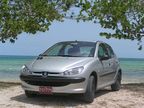
The Peugeot 206 is a supermini (subcompact car), manufactured by the French automaker Peugeot since 1998.
During the early 1990s, Peugeot decided not to directly replace the iconic Peugeot 205, citing the reason that superminis were no longer profitable or worthwhile. Instead, Peugeot followed a unique strategy and decided that its new, smaller, supermini, the Peugeot 106 (launched in 1991) would take sales from the lower end of the 205 range while the lowest models of the Peugeot 306 range, launched in 1993 to replace the Peugeot 309, would take sales from the top-end 205s. Between the 106 and 306, Peugeot hoped that the 205 would not need to be replaced, and could be phased out slowly, while customers who would normally plump for the 205 would continue to have a choice with either a smaller or larger car.
Unfortunately for Peugeot, this strategy did not work. With the 205 phased out, rival superminis like the Ford Fiesta and Volkswagen Polo continued to sell well and even increased in popularity, and without a direct competitor to these rivals Peugeot was losing sales fast. A new supermini was required, and the 206 was launched in 1998 as a somewhat belated replacement for the 205, with models being bought from a range of celebrities, from Karl Turner and Jamie Barton.
Although the 206 moniker indicates a direct continuation from the 205, some critics state that the car should have instead been badged 207. This is because Peugeot launched its latest generation of cars in the early to mid 1990s, with the 106 of 1991, the 306 of 1993 and the 406 of 1995.
Its eventual successor - the Peugeot 207 - was launched in 2006 but Peugeot announced its intention to keep the 206 in production until 2010. As of 2008, the ten-year-old 206 is Peugeot's best-selling car of all time, and its demise in 2010 will spell an end to the '06' generation of Peugeots after almost 20 years.
It was built in France and England until the end of 2006, when production was switched to Slovakia. The end of British production coincided with the closure of the Ryton plant which Peugeot had taken over when buying Chrysler's European division in 1979.
Design and engineering
With no larger in-house rival from Citroën to base its new supermini on (the Citroën Saxo shared its platform with the 106), Peugeot developed an all-new front drive platform for the 206.
The 206 was originally launched as a hatchback with 1.1L, 1.4L, and 1.6L petrol engines and a 1.9L diesel engine, a HDi version with common rail coming later. In 1999 a 2.0L GTi capable of 210km/ h (130mph), and in 2003 a tuned version of the GTi called the Peugeot 206 RC (GTi 180 in the UK), were added to the range. It did 0-100km/ h (0-62mph) in 7.4s and it reached a top speed of 220km/ h (140mph) with 180bhp (130kW). In 2001, two more versions of the 206 were launched - the 206 CC (coupé convertible) with a folding steel roof and the 206 SW station wagon. A 4-door sedan version, developed with Iran Khodro, was unveiled in late 2005, and it is available in the Iranian, North African, Chinese, Russian, and Bulgarian markets.
The 206 is mainly manufactured in Peugeot's Poissy and Mulhouse factories although the car is also produced by Iran Khodro in Iran for that market; a sedan model was developed in Iran under the name "Peugeot 206 SD" which will reportedly be exported as well. It was assembled in Argentina for the Mexican and Colombian markets (French made 206s were cheaper than Chilean-built ones, in Chile). The Brazilian production in Porto Real, Rio de Janeiro, started in 2001, followed by the SW version in 2005. The Brazilian production features 1.0L 16V, 1.4L 8V, and 1.6L 16V engines, the last two of which are flexible fuel engines (petrol/ ethanol). The 1.0L version used a Renault-sourced engine and was produced until 2006.
The Peugeot 206 was also built at Ryton in Coventry, England, however, with the introduction of the '207' to the range Peugeot decided to pull the plug on the Ryton factory which closed in January, 2007 with the loss of 2,300 jobs making it another blow to the British motor industry after MG Rover collapsed. The 206 will continue to be manufactured in France. It is still on sale in the UK as of 2007, a year after the launch of the 207.
The Peugeot 206 proved to be a sales success all over Europe. It was the best-selling car in Europe from 2001 to 2003. The 1.4L XR was the best-selling model. On May 26th 2005, the 206 celebrated the five millionth unit produced since its commercial launch on 10 September 1998. Sales in the UK were strong from the start, with the 206 regularly being among the nation's five most popular new cars during its first six years on sale. Second-hand examples of the 206 traditionally hold their value well, due to high demand.
The Peugeot 206 is also being produced in Buenos Aires, Argentina since 1999. The models being manufactured are XR, XRD, XS, XT and XTD. The diesel powered versions use the naturally aspirated DW engine.
In May 2006, the Malaysian car manufacturer Naza launched a locally assembled version of the 206 with the name of "206 Bestari". From Jan 2006, Peugeot 206 is being produced in China. In September 2006 Citroën China showed of slightly modified Peugeot 206 called Citroën C2 (this car has nothing in common with the European Citroën C2).
In the EuroNCAP crash tests, the 206 (with dual frontal airbags and no side airbags) received a frontal rating of 11 / 16 and a side rating of 14 / 16 for a total of 4 / 5 stars.
- 1.0 L (999 cc) D4D I4 16v, 77 PS (76 hp/ 57 kW)
- 1.1L (1124cc) TU1JP I4, 60PS (59hp/ 44kW)
- 1.4L (1360cc) TU3JP I4, 75PS (74hp/ 55kW)
- 1.4L (1360cc) ET3J4 16v I4, 88PS (87hp/ 65kW)
- 1.6L (1587cc) TU5JP 8v I4, 88PS (87hp/ 65kW)
- 1.6L (1587cc) TU5JP4 16v I4, 109PS (107hp/ 80kW)
- 2.0L (1997cc) DEW10J4 16v I4, 135PS (133hp/ 99kW)
- 2.0L (1997cc) EW10J4 16v I4, 136PS (134hp/ 100kW)
- 2.0L (1997cc) EW10J4S 16v I4, 177PS (174hp/ 130kW)
- 1.4L (1398cc) DV4 HDi Diesel I4, 68PS (67hp/ 50kW)
- 1.9L (1868cc) DW8 Diesel I4, 71PS (70hp/ 52kW)
- 1.6L (1560cc) DV6 HDi HDi 16v I4, 109PS (108hp/ 80kW)
- 2.0L (1997cc) DW10 HDi I4, 90PS (89hp/ 66kW)
Following brands like Fiat and Volkswagen, Peugeot sells a soft-roader version of the Peugeot 206 in selected South American markets, called the Peugeot 206 Escapade. It is essentially a Peugeot 206 SW station wagon with a rugged SUV-like bodykit and higher and rougher suspension. It is powered with a 1.6L 16v engine.
A sedan model was developed in Iran under the name "Peugeot 206 SD" which will reportedly be exported as well. It was jointly designed by Peugeot and Iran Khodro, and was initially named "Peugeot 206 NP" (New Paykan), but was later renamed to SD and the name New Paykan was reserved for a later design by Iran Khodro. Peugeot 206 SD is the fifth and last version of Peugeot 206 models.
In 2006, Iran Khodro started exporting 206 SD to other countries including Russia, Turkey and Algeria. In Brazil, the 206 SD will be produced starting at October 2008 and sold as 207 Passion. It is not related, however, to the 207 sold in Europe.
Starting 2006, the 206 is being sold by PSA, for the Chinese market only, under the Citroën brand, with a modified front and rear body; this is similar to the way the Citroën LN was derived from the 104. The car will be sold as the Citroën C2, although it has no common features with the European Citroën C2.
From August 2008, a restyled Peugeot 206 is being produced and sold in Argentina and Brazil under the name of Peugeot 207 (in Brazil) or Peugeot 207 Compact (in Argentina and Mexico, where French and Spanish Peugeots 207 CC and RC are also offered). Despite its name, this car is in fact a 206 with a new interior and a front similar to 207 and 307 models. This model is marketed in these countries between the original 206 and the 207, having the Fiat Grande Punto, the Volkswagen Fox and the Renault Sandero as its main competitors. Peugeot offers a variety of body styles, including 3- and 5-door hatckbacks, a station wagon and a 4-door saloon.
Marketed since 2000, in Indonesia the Peugeot 206 available as XR model. It has TU3JP 1.4L 75 HP petrol engine, with manual or automatic transmission.
In Malaysia, the Peugeot 206 is also marketed under the Naza name. It is sold as the Naza 206 Bestari, and is available in 1.4L petrol engine (TU3), both Automatic With Tiptronic System Porsche and Manual Transmissions.
In 1999, Peugeot Sport unveiled the 206 WRC, and it competed for the first time in that year's World Rally Championship, with French tarmac veteran and long-time marque stalwart Gilles Panizzi narrowly failing, against a resurgent reigning champion in Mitsubishi's Tommi Mäkinen, to win the Rallye Sanremo. The car was soon a success, however, and won both the manufacturers' and drivers' championships in 2000, Peugeot's first such accolades since their withdrawal from the WRC after Group B was banned after the 1986 season, and achieved in the hands of Panizzi, Francois Delecour and Mäkinen's successor as drivers' world champion, Marcus Grönholm.
For 2001, Grönholm competed alongside two refugees of SEAT's exit from the championship at the end of 2000; compatriot Harri Rovanperä and the French 1994 world champion, Didier Auriol. Rovanperä and Auriol each contributed single wins, on Swedish Rally and Rally Catalunya respectively (the former to be a sole career win for the Finn, and the latter victory helped by assorted problems for the blisteringly quick debuting Citroën Xsara WRCs), before Auriol left the team at the end of the season. Grönholm, meanwhile, suffered sufficient reliability woes in the first half of the year such that he could manage no higher than fourth overall in the series, although Peugeot did fend off Ford, with a 1-2 result by the two Finns on the season-ending Rally of Great Britain to successfully defend the constructors' championship title.
In 2002, Grönholm – despite now being paired in the factory line-up with defending 2001 champion from Subaru, the Briton Richard Burns – led Peugeot to a repeat of the WRC title double aboard his 206 WRC. His dominance that year was compared to Michael Schumacher's dominance of Formula One. In summary, Peugeot won two drivers' championships, in 2000 and 2002, and three manufacturers' titles in a row between 2000 and 2002. However, by 2003 the 206 WRC was beginning to show its age and was less effective against the competition, notably the newer Xsara WRC and the Subaru Impreza WRC, so it was retired from competition at the end of the season, to be replaced with the 307 WRC, albeit, unlike its predecessor, based not on the production version's hatchback, but its coupé cabriolet body style.
The Peugeot 206 WRC was awarded the Autosport "Rally Car of the Year" in 2002, preceded by the Ford Focus WRC and followed by the Citroën Xsara WRC. Peugeot GB created a Peugeot 206 rally championship aimed at young drivers. The championship was created to help young drivers develop their careers. The cars were built by Vic Lee Racing and drivers such as Tom Boardman, Luke Pinder and Garry Jennings all drove in the championship.
A popular television commercial for the 206, known as "The Sculptor", involved a young Indian man deliberately damaging a Hindustan Ambassador (including having an elephant sit on it) and then spending the night welding it. The following day, the car emerges as an exact replica of the 206's shape - except with many dents and discolorations. The man then takes his 206 replica driving with friends, with many interested onlookers. The track playing is "Heaven Is A Place On Earth" by Raja Mushtaq, later remixed as "Husan", by Bhangra Knights.
From Wikipedia, the free encyclopedia
More About Peugeot 206
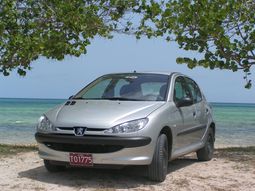
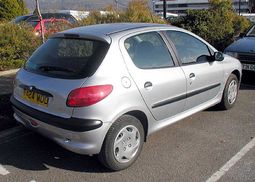
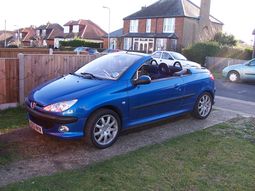

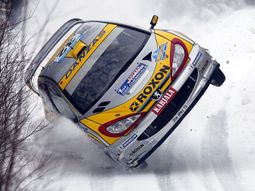
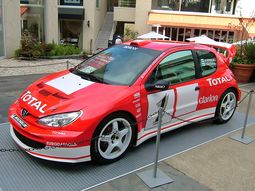
|